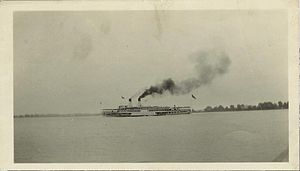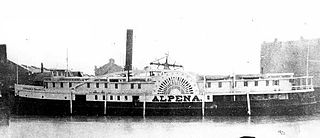
The PS Alpena was a sidewheel steamer built by Thomas Arnold of Gallagher & Company at Marine City, Michigan in 1866. She was operated by the Goodrich Line after being purchased from Gardner, Ward & Gallagher in April 1868. The Alpena sank in Lake Michigan in the "Big Blow" storm on October 15, 1880, with the loss of all on board.
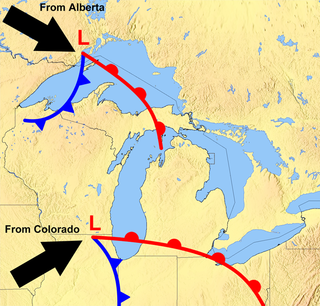
The Great Lakes Storm of 1913 was a blizzard with hurricane-force winds that devastated the Great Lakes Basin in the Midwestern United States and Southwestern Ontario, Canada, from November 7 to 10, 1913. The storm was most powerful on November 9, battering and overturning ships on four of the five Great Lakes, particularly Lake Huron.

The SS Christopher Columbus was an American excursion liner on the Great Lakes, in service between 1893 and 1933. She was the only whaleback ship ever built for passenger service. The ship was designed by Alexander McDougall, the developer and promoter of the whaleback design.
Detroit and Cleveland Navigation Company, often abbreviated as D&C, was a shipping company on the Great Lakes.
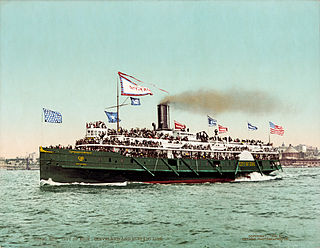
The SS City of Erie was a sidewheeler steamboat on Lake Erie. It was famous for being one of the fastest ships on the Great Lakes, at the time. It also won a race against a newer, rival ship.
Frank E. Kirby was a naval architect in the Detroit, Michigan area in the early 20th century. He is widely regarded as one of the greatest naval architects in American history.
The American Ship Building Company was the dominant shipbuilder on the Great Lakes before the Second World War. It started as Cleveland Shipbuilding in Cleveland, Ohio in 1888 and opened the yard in Lorain, Ohio in 1898. It changed its name to the American Ship Building Company in 1900, when it acquired Superior Shipbuilding, in Superior, Wisconsin; Toledo Shipbuilding, in Toledo, Ohio; and West Bay Shipbuilding, in West Bay City, Michigan. With the coming of World War I, the company also acquired Buffalo Dry Dock, in Buffalo, New York; Chicago Shipbuilding, in Chicago, Illinois; and Detroit Shipbuilding, in Wyandotte, Michigan. American Shipbuilding ranked 81st among United States corporations in the value of World War II military production contracts.
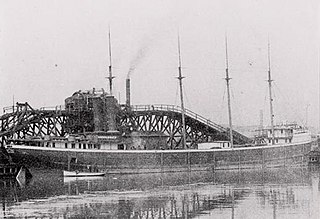
The SS Kaliyuga was a steamship that sank with the loss of 16 lives on Lake Huron on the night of October 19/20, 1905. The wreck of the Kaliyuga has never been found, and the cause of her sinking remains a mystery.

SS Ira H. Owen was a steel-hulled American lake freighter in service between 1887 and 1905. One of the first steel lake freighters, she was built in 1887 in Cleveland, Ohio, by the Globe Iron Works Company, and was built for the Owen Line of Chicago, Illinois. Early in her career, Ira H. Owen carried iron ore from Escanaba, Michigan. In April 1898, Ira H. Owen was chartered by the Baltimore & Ohio Railroad. She was sold to the National Steamship Company of Chicago, on December 30, 1899, for whom she frequently carried coal and grain. Throughout her career, Ira H. Owen was involved in multiple accidents and incidents.
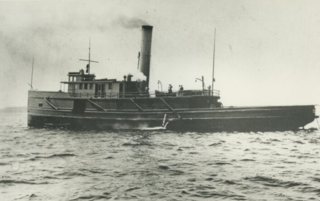
The Balize was a wooden hulled tugboat that operated on the Great Lakes in the United States and Canada. She was powered by a single cylinder steam powered Steeple engine and fueled by one coal-fired Scotch marine boiler. She had a length of 131.50 feet, a beam of 21.58 feet and height of 12 feet.

SS Choctaw was a steel-hulled American freighter in service between 1892 and 1915, on the Great Lakes of North America. She was a so-called monitor vessel, containing elements of traditional lake freighters and the whaleback ships designed by Alexander McDougall. Choctaw was built in 1892 by the Cleveland Shipbuilding Company in Cleveland, Ohio, and was originally owned by the Lake Superior Iron Company. She was sold to the Cleveland-Cliffs Iron Company in 1894 and spent the rest of her working life with it. On her regular route between Detroit, Escanaba, Marquette, and Cleveland, she carried iron ore downbound, and coal upbound.

Walk-in-the-Water was a sidewheel steamboat that played a pioneering role in steamboat navigation on the Great Lakes. She was the first such craft to run on Lake Erie, Lake Huron and Lake Michigan. Launched in 1818, she transported people and supplies to sites and points of interest around the Great Lakes, before being grounded and wrecked in a gale force storm in Buffalo's bay in 1821. According to some sources, Walk-in-the-Water's name originated from an Indian's impression of a steamboat moving ("walking") on the water with no sails.

SS Russia was an iron-hulled American Great Lakes package freighter that sank in a Lake Huron gale on April 30, 1909, near DeTour Village, Michigan, with all 22 of her crew and one passenger surviving.
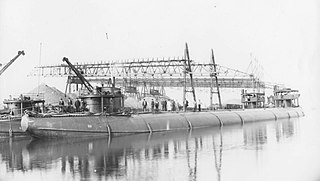
115 was an American whaleback barge in service between 1891 and 1899. She was built between May and August 1891, in Superior, Wisconsin by Alexander McDougall's American Steel Barge Company, for the "McDougall fleet", based in Buffalo, New York. She was one of a class of distinctive, experimental ship designed and built by McDougall. The whalebacks were designed to be more stable in high seas. They had rounded decks, and lacked the normal straight sides seen on traditional lake freighters. 115 entered service on August 25, hauling iron ore from Superior.

104 was an American whaleback barge in service between 1890 and 1898. The fourth whaleback constructed, she was built between October 1889 and February 1890, in Duluth, Minnesota by Alexander McDougall's American Steel Barge Company, for McDougall's fleet of the same name, based in Buffalo, New York. She was a whaleback, a class of distinctive, experimental ship designed and built by McDougall. The whalebacks were designed to be more stable in high seas. They had rounded decks, and lacked the normal straight sides seen on traditional lake freighters. 104 entered service on April 21, hauling iron ore from Two Harbors, Minnesota.
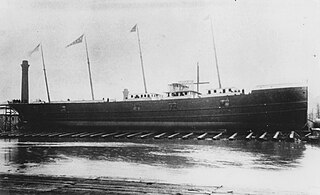
SS Cayuga was a steel-hulled American package freighter in service between 1889 and 1895. She was built in 1889 in Cleveland, Ohio, by the Globe Iron Works Company for the Lehigh Valley Transit Company of Buffalo, New York. One of five identical sister ships, Cayuga entered service in 1889, carrying package freight between Buffalo and Chicago, Illinois, also making stops in Milwaukee, Wisconsin, and Gladstone, Michigan. Prior to her sinking, Cayuga was involved in two accidents. In the first in 1890, when she went aground in a gale just outside of Buffalo harbour; six tugboats managed to pull her free that same day. The second accident occurred in 1891, when Cayuga was involved in a collision with the package freighter Delaware near Cheboygan, Michigan.

PS Keystone State was a wooden-hulled American paddle steamer in service between 1849 and 1861. She was built in 1848 in Buffalo, New York, by Bidwell & Banta for ship-owner Charles M. Reed of Erie, Pennsylvania, and operated as part of his "Chicago Line". A luxuriously furnished palace steamer, she operated between Buffalo and Chicago, Illinois, while also making stops at various other ports. She was built for the passenger and package freight trade, frequently carrying both wealthy passengers and European immigrants who desired to settle in the Midwestern United States. Due to the Panic of 1857, Keystone State and several other paddle steamers were laid up. When the American Civil War began in 1861, she was refurbished, and put back into service.

SS Chester A. Congdon was a steel-hulled American lake freighter in service between 1907 and 1918. She was built in 1907 by the Chicago Shipbuilding Company of South Chicago, Illinois, for the Holmes Steamship Company, and was intended to be used in the grain trade on the Great Lakes. She entered service on September 19, 1907, when she made her maiden voyage. In 1911, Salt Lake City was sold to the Acme Transit Company. A year later, she was transferred to the Continental Steamship Company, and was renamed Chester A. Congdon, after lawyer and entrepreneur Chester Adgate Congdon. She was involved in several accidents throughout her career.

